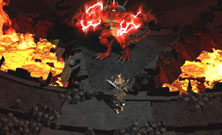
If Dante’s Inferno was redone today, it would be published by Blizzard as a kick-ass sequel. Even the Lord of Terror himself would purchase a copy. When Diablo’s final cinematic rolled back in 1996, we knew what we wanted, and what was coming: A SEQUEL. Now we finally have what has to have been the most anticipated software release in recent memory, Diablo 2. Two weeks later, and over a million copies sold, but are the numbers telling you anything about the game itself? No. As in the SCREAM movies, there are rules for a successful sequel, and Blizzard’s well-oiled machine follows them like clockwork:
Bigger is better – With indoor maps from 1 to 5 levels deep, and large exterior maps, even using the waypoint/teleporter areas, you’re still going to find yourself running around alot, getting to places. This world is far from small, especially compared to the original Diablo.
Up the body count – Be prepared for a sore wrist/hand (or get some nice ergo mouse with a wrist brace, you’ll need it).
Always leave yourself open for a sequel. Don’t wish to spoil it for those who haven’t finished, but I can honestly say I didn’t see the plot twist in the epilogue.
Bring back familiar characters into the new story… If Deputy Dewey can come back and survive getting stabbed by all the killers, then why not gaming characters. Once again Deckard Cain is there to advise you.
Be over the top – Not only must you face Diablo, but Mephisto, Baal, and others.
Keep it simple, fans will pick apart a game too much if you give them too much to play with. The controls are essentially identical to the original Diablo, as is the way magic items are handled, but with some new twists.
Controls have changed little since the release of the original Diablo. Left clicking opens doors and chests, as well as attacks the enemy. You can use some character skills as attacks on the left button as well. Right clicking activates items like scrolls, and skills specific to a character class.
Indicators: The toolbar now is laden with all sorts of bars and popups to assist you. Since Diablo2 now takes stamina(E) into account for things like running, a meter exists showing this new attribute, as well as one for showing how close you are to leveling up(D). The required Health(A)/Mana(I) spheres are there as well. Other indicators on the toolbar include: Run mode toggle(C), current left-click definition(B), current right-click definition(H), and potion hotkeys(G). For those that don’t like to use the keyboard to bring up the various popups like quest logs, inventory, character info, skill tree, and Automap, this pop-up toolbar(F) allows you to click activate them instead.

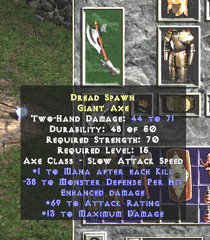
Items: A diverse number of weapons and items exists in the Diablo 2 world, and with Diablo’s way of making magic items(colorful and descriptive prefixes and suffixes to the base weapon name indicating it’s powers), a myriad of magical items exists as well.
Ambient stuff: Each of the 4 Acts comprising the games storyline are all set in drastically differing landscapes, complete with a musical background consistent with the setting. Act I consists mostly of light forest, open plains, and some rocky terrain. Pretty barren and plainish. Act 2 however ups the stakes with a detailed mid-east motif… spired palaces, people in turbans and fezzes, sand dunes with animal bones, and vultures.
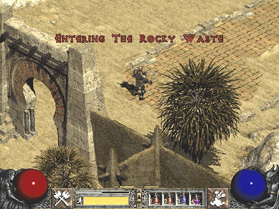

The progression into Act 3 changes the world again into a dense tropical jungle, complete with coral snakes crawling around, pygmy warriors, and shamans who breathe fire.
Act 4 is rather bland compared to the other acts, afterall, since when is HELL a picturesque landscape. Act 4 consists of 3 main sections, in a slightly rocky and flat terrain, called the River of Flame. While walking around in Hell, your “home base” for this act is the Fortress of Pandemonium, the last outpost of the forces of good on the shores of Hell. Here, you come face to face with Tyreal, where the final bits of the story, including his feelings toward Cain, the last of the Horadrim Mages, are made known.
Each of the 5 character classes (Sorceror, Barbarian, Paladin, Necromancer, and Amazon) each have their own skill set. Each time you attain a new level, you get a certain amount of points to distribute to your primary character traits (Strength, Dexterity, Vitality, and Energy), and 1 SKILL POINT. Skill points can be used to obtain NEW skills, or improve ones you’ve previously purchased with skill points.
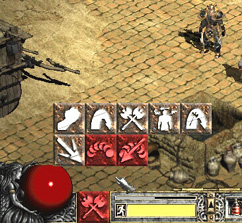
Each skill tree for the different character class, has several branches, so to get skills lower on the list, you must purchase the skills that connect to them further down the skill tree. Also, some skills cannot be learned until higher levels, close to the end of the game.
Barbarian using WAR CRY, a skill in the Barbarian’s “War Cries” skill tree. Skills can be active(as in an attack/defensive skill) or passive(run faster, natural body armor, more stamina).
Item Sets:
Some items are unique, and part of “matched sets”. These items have GREEN names. When you put the mouse over one of these items, it will tell you the other items necessary to complete it. When all pieces are assembled, you get bonuses in addition to the individual bonuses given by the individual items.
Socketed Items:
Some items you will find, or buy, in your travels are “SOCKETED”. Sockets are slots on the item that various gems you find as treasure can be placed into. The power/function that gets added depends on the gem type, quality level, and what type of item you are placing them into.
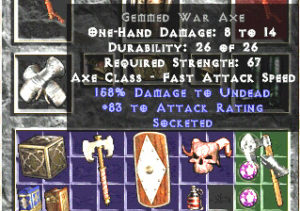
Closing Notes:
While the graphics are at 640×480, and do not even remotely come close to taxing today’s video cards, the game does manage to produce some nice effects sequences, and draw you into the expansive piece of rpg-influenced computer cocaine for the chronic fantasy-gamer.
Automap –
In a large world such as this, not ONLY do you need interior mapping, but also exterior mapping, to help navigate the extensive area in each act. By default this is activated by hitting the TAB key on PC’s, or by clicking the AUTOMAP icon on the pop-up toolbar. Items such as powerup shrines, waypoints, and major terrain features are all mapped. I wish however, they had allowed you to put NOTES into the map, like Might and Magic 8 allowed, to help remember what shrines do what, and what each dungeon/crypt entrance was for (“This crypt has the Horadric Headpiece for the Horadric Staff”).
Save games –
Unlike Diablo, where you could save ANYWHERE outside of a dungeon level, with a town portal, or other spell, cast and reload the game to find them active, this is not the case with Diablo 2. When you exit the game and save, all powerup spells, and town portals, dissipate, and all monsters and traps, get restored to their original state. All you keep from a save game is your gear, money, and any waypoint teleporters you have activated since starting the game. This was an unpleasant suprise the first time I saved a game, but after getting used to it, I found it helpful, especially when I needed to level up to face an opponent who was kicking by butt repeatedly because my stats were too low, or I needed money for an item that would hurt him enough to survive the fight.
The game allows for single player, as well as multi-player via Battle.net, or TCPIP connections between two players direct over the net. The game comes preconfigured with hotkeys for network play, including voice messages to communicate with other players without typing ( phrases can be spoken to other players, in your characters voice, like : “For you”, “Follow me”, and “DIE!!!”(for the socially challenged gamer). The cinematic sequences, detailing the fate of the Dark Wanderer (the hero from the original Diablo), and Marius, his traveling companion, are excellent. The story elements, like the fight between Baal and Tyreal, and Arch-Angel who, against common practice by the other Arch-Angels, has a soft spot for humanity and is trying to assist them in destroying the 3 Prime Evils (Baal, Mephisto, and of course, their brother, Diablo) are presented very well, and in dramatic fashion. Yes, I’ve finished it, and no, I’m not going to give away the ending. I will say only this about the epilogue: My jaw dropped, and I was taken by suprise. Hopefully you will get so caught up in the game, you’ll be suprised, and pumped up at the ending.
Verdict: 93%
The Good:
easy to learn interface
addictive gameplay
excellent cinematics driving the plot elements
immersive ambient music to set the mood.
The Bad:
Greatly expanded rehash of the original(but enough new stuff not be “the same thing”),
Because the game has been 3 years in the making, technology has changed enough to make the graphics look slightly dated.
Price: $59.95 (Blizzard Direct Purchase) Publisher/Developer: Blizzard Entertainment Blizzard: Diablo2 Official Site: